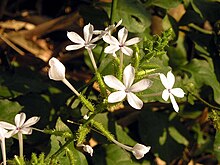|
Plumbago zeylanica
Plumbago zeylanica, commonly known as Ceylon leadwort, doctorbush[2] or wild leadwort,[3] is a species of plumbago with a pantropical distribution. Carl Linnaeus described the paleotropical P. zeylanica and Neotropical P. scandens as separate species, but they are currently considered synonymous. DescriptionPlumbago zeylanica is a herbaceous plant with glabrous stems that are climbing, prostrate, or erect. The leaves are petiolate or sessile and have ovate, lance-elliptic, or spatulate to oblanceolate blades that measure 5-9 × 2.5–4 cm in length. Bases are attenuate while apexes are acute, acuminate, or obtuse. Inflorescences are 3–15 cm in length and have glandular, viscid rachises. Bracts are lanceolate and 3-7 × 1–2 mm long. The heterostylous flowers have white corollas 17–33 mm in diameter and tubes 12.5–28 mm in length. Capsules are 7.5–8 mm long and contain are reddish brown to dark brown seeds.[1] Distribution and habitatPlumbago zeylanica grows throughout the tropical and sub-tropical climates of the world,[citation needed] including Australia and India. In Australia, it grows in the understory of monsoon forests and vine thickets from sea level to 900 m.[4] In Dhofar, Oman, this species is often found growing on Olea trunks.[5] EcologyPlumbago zeylanica is a food plant for the Cassius blue (Leptotes cassius), marine blue (L. marina), and zebra blue (L. plinius) during their larval stages.[4][6][7] Traditional medicineEarly folk medicine used the crushed plant internally and externally as an abortifacient.[5] In Ayurveda, P. zeylanica is known as chitrak, meaning "the spotted one". It is used with other herbs to lessen its intense pungency.[8] References
External links
|
||||||||||||||||||||||||||||||
